The most comprehensive IM client review of popular PC protocols
Eh. I observe the QIP changes , the heyday of many other clients, watch how the Jabber world is taking over and how AOL is rushing about in search of a partner ... and I see that most do not care: how they used the once installed program and remain in it.
No, my topic review does not call for using any special new customers, but I hope it will make you think and choose the most suitable one. :)
Most likely, many Khabrovsk residents already have their favorite client, for which they are ready to strangle any "ill-wisher" :) I ask holivarschik to leave, here I just do a review, draw a line under the current state of things. For those who are interested, who are hungry for a new one, who are fed up with their means of communication and other people who are interested, please view the review. IM clients with a graphical user interface on a PC (Windows and Linux) will be considered .
Attention! ~ 1.5 Mb pictures, and a sea of text
For the review we used:
Netbook
ASUS EeePC 1000H
System: Windows XP SP3
PC
Core 2 Duo E7200
System: Ubuntu Linux 9.04

Version: 2.5.8
Protocols: Jabber (XMPP), ICQ , MSN, IRC, SIP, Bonjour iChat, Gadu-Gadu, Novell GroupWise, OpenNAP, SILC, Zephyr, Lotus Sametime, QQ, MySpaceIM + plugins
OS: Linux, Windows, MacOS
Size: 13.7 Mb; Uses
memory: 50 Mb;
Amazes the number of supported protocols. However, as in many other similar clients, Mail.ru is missing here.
The client itself is both simple and convenient, and very functional. The program comes with a standard set of modules, and the program itself is not deprived of chips. This is what distinguishes Pidgin from other programs - there are "chips" that are difficult to see elsewhere. Well, for example, "user tracking", which greatly expands the possibilities of notification. There are some individual settings, for example, some lacking function of setting your own avatar, instead of the avatar that the interlocutor offers you.
Of course, a client with so many protocols needs to have meta contacts, and even Pidgin can cope with this task.
It seemed nowhere to throw a fly in the ointment, but no! Pidgin has deficiencies: these are statuses and the absence of a “service review”. Yes, the statuses in Pidgin’s standard work fine, but no activities, moods, or, more understandably for ICQ fans, xStatuses, were planned. Here it is. The haVok habrozer suggests that the xStats are promised in version 2.7.0 , you can only wait and hope. Since the protocols do not support the extended statuses, the
“Service Overview” is needed, for example, to add transport. Although on the other hand, this is a multi-protocol client, transports are not needed here in most cases.
The client itself will suit the "average user", but still no more than that, since there is no way to modify the interface.
For whom :
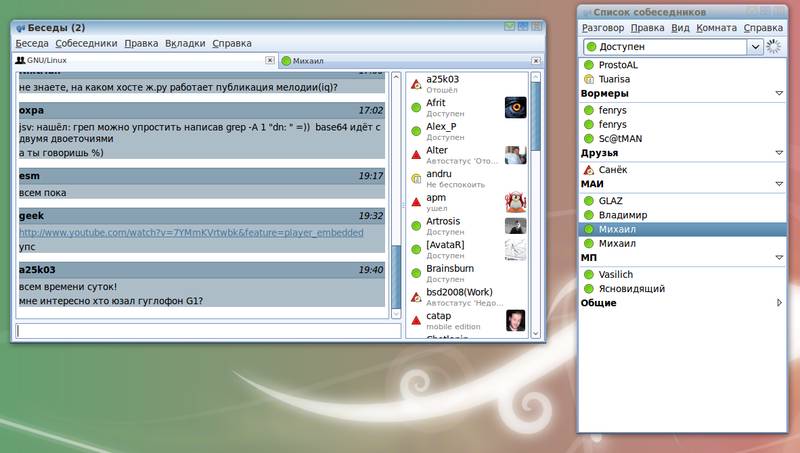
Version: 2.27.5
Protocols: XMPP (Jabber), ICQ , SIP, AIM, MSN, QQ, Yahoo, GroupWise, Gadu-Gadu, Salut
OS: Unix-like
Site: http://live.gnome.org/Empathy
Program it turned out to be so simple that there was nothing to “review” it.
In general, the program looks like it is Pidgin at the time of the beginning of development. This feeling arises due to the contrast of functionality and interface. The interface is terribly minimalistic, it is simple as 5 kopecks, so simple that even the icons at the contacts of different protocols do not differ! But after looking at my list, don’t think that I love it when a sheet of paper lies in front of me, it’s just impossible to do the same contact list. By functional, I mean the number of supported protocols, including voice communication over SIP and Google Talk . In addition, immediately after installation, the program correctly detected that I had profiles configured in Pidgin, and it also successfully (with my permission) imported them.
Naturally, this thing does not support any additional statuses. But even worse, Service Overview is not supported either, that is, you will not be able to work with Jabber transports.
For whom :

Version: 5.0.0 alfa (07/30/09, updated to 6.08.09)
Protocols: ICQ
OC: Windows
Size: 1.2 Mb ; Uses
memory: 10 Mb;
Website: imadering.com
I was shocked to see this program! Memories immediately flooded when QIP was easier, the air is cleaner, and the girls are more beautiful ... Alas, it turned out that the program is at a very early stage of development. No, in fact, it has already been developed for a long time, but the author decided to start the project again, and therefore I was at first slightly surprised that the jabber was not connected, and then I felt completely lonely after seeing an absolute lack of settings. Despite this, the client is apparently under active development, many features of the ICQ protocol are already supported (including x-statuses).
For whom :
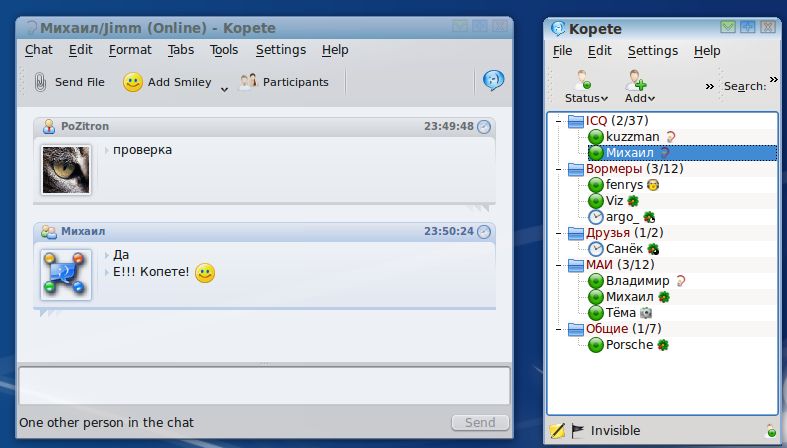
Version: 0.70.2 (2.04.09)
Protocols: ICQ , Jabber , AIM, Yahoo, Windows Live, QQ, Gadu-Gadu, Bonjour, GroupWise, Meanwhile, SMS, WinPopup (description: sends WinPopup messages)
OS: Unix- similar
takes up memory: 27 Mb
Site: kopete.kde.org Pidgin's
answer? Or Pidgin Kopete's answer? I don’t know, but this is a monster, and very impressive. Unlike Pidgin, Kopete lacks that gracefully crammed settings in different angles. All settings drop out from somewhere from the menus or can be found on some tab, or hidden in a separate menu as a separate line in a separate window ... In general, despite the external simplicity, the client surprises with his pop-up-check-out-creep settings. In general, it’s somehow good, because no one has yet died from a flexible client :) In addition, Kopete supports x-statuses and moods (though I didn’t see activities there ).
The problem with Kopete is its focus on KDE. I admit that in KDE it looks beautiful and probably fits into the interface, but in Gnome it is out of place and it sometimes even seems to me that it slows down. Besides who wants to drag a bunch of KDE'shnyh libraries? (I'm talking about the total traffic necessary to download the program).
For whom :
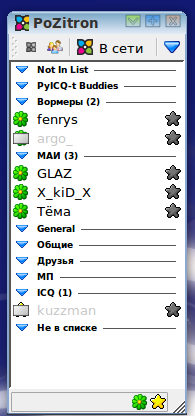
Version: 0.9.5.2 (11.28.08)
Protocols: ICQ , Jabber , AIM, MSN, Yahoo, LiveJournal
OS: Windows, Linux, FreeBSD
Memory space: 12 MB
Website: sim-im.org
Quite a strange project, I can’t name any features. There are cons: the interface is bad and there are no x-statuses, but I do not see any advantages. Just a program. There are some chips of their own, but there are few of them and they are not worthy of mention.
In addition, the client is more focused on KDE and does not seem to be developing.
For whom :
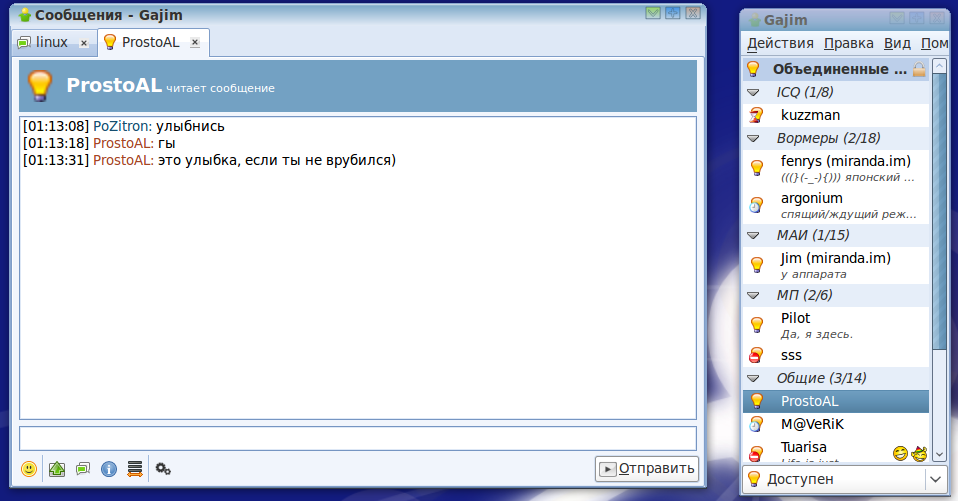
Version: 0.12.3 (12.06.09)
Protocols: Jabber
OS: Linux, BSD, Windows ; Uses
memory: 50 Mb;
Website: gajim.org
Once upon a time, I started this program for the first time. That day I rubbed my hands and thought “finally I found a simple jabber-client for friends who just need a simple one without any extra buttons!”. For a while, to help my friends, I sat on Gajim ... what was my surprise when I realized that I was just sitting on it! Gajim surprisingly accurately found the middle ground between beauty, functionality and simplicity.
Beauty: Gadzhim is not decorated without the possibility of using skins. However, the interface is so licked that it is not necessary.
Functionality: despite its apparent simplicity, the clientperfectly fulfills its duties. The client fully supports Jabber with all its documented features. Many things are thought out for pleasant communication.
Simplicity: all the necessary settings are where they should be. The number of settings (visible) is quite modest, which does not allow you to get confused in the client, but there is a special button with an advanced settings tree where you can configure the client well once and forget about them forever :)
Of the minuses, it is worth noting sometimes errors (but not client, but simply showing that an error has occurred) and freezes when it is not possible to connect to the server.
For whom :

Version: 0.13 (07/27/09)
Protocols: Jabber
OS: Windows, Linux, Mac OS
Takes up memory: 30 mb
Website: psi-im.org
It looks like a simple Jabber-client. The regular version does not support activity; the advanced versions (Psi +) partially support them. Moods are supported, but pretty banal - just text, without an icon. A music show (tune) is also present.
As in Gajim, many settings are hidden from the user in a special settings tree, which allows you to quickly change frequently used settings, while leaving the ability to sometimes “fine-tune” the client. "In general, the client is not inferior to Gajim in functionality. But the external kind of an amateur.
For whom :
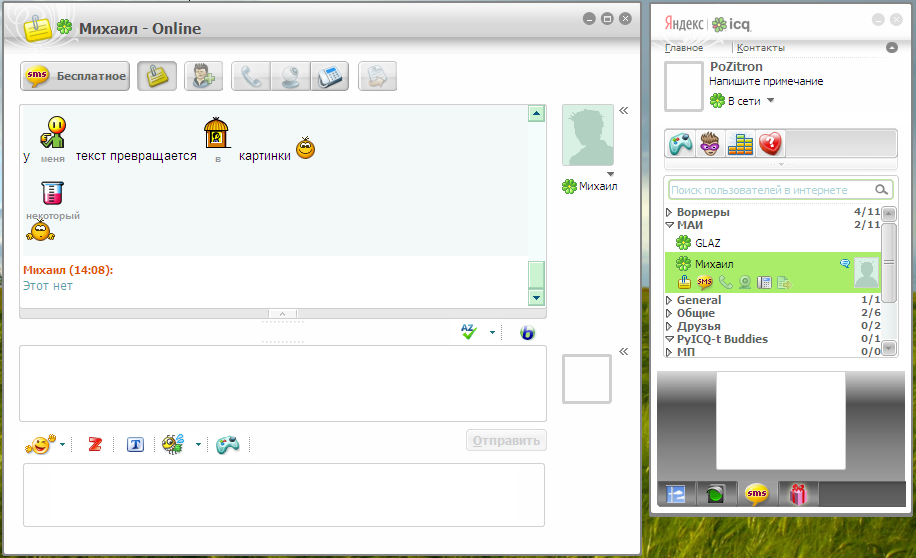
Version: 6.5
Protocols: ICQ
OS: Windows
Size: 15.8 Mb + required updates;
memory: 77 Mb
Website: icq.yandex.ru The
answer to Yandex Rambler is “Yandex with Yandex taste”. When I saw how the installation wizard starts and the hard drive rustles helplessly, I realized that I was putting the official ICQ. Seeing a nice plastic installer interface that any 5th grader could do, I clicked “Next” and, remembering the situation with QIP, clicked on “Custom installation”. So it is, immediately hidden appearedpoints where I was not asked to choose which ICQ components I want to install, but 3 ticks were offered with all sorts of “make yandex home page” and other “advertising”. Having removed all the checkmarks, I started the installation. It lasted quite a long time, without asking me to climb something to download from the Internet, and so on, as befits an official client. At the end of the installation, I immediately checked “Run ICQ”, after which I was again waiting for downloading updates of an already installed client (for those who don’t know, the official client will not work without updates, so one day you can be left without ICQ). Next, the same plastic-white-gray interface appeared in front of me. Having visited Yandex with Yandex taste, I was convinced that this client does not contain any changes compared to regular ICQ.
I tried to send SMS, of which 20 there are "free". It did not reach the addressee. Constantly the field below is closed with a white square “Chivelam” - apparently there should be an advertisement. This square itself occupies just half of the list, which, incidentally, is not subject to special resizing. It’s painful to look at the list of contacts, it’s the same as reading a book at a distance of 5 meters - a little contacts are placed close because of the huge “cap” and useless flash insert below.
But in this client there are completely useless “tricks”: games (by the way, my favorite “Lamb War” - I recommend), tZer (extremely dumb flash cartoons sent to the interlocutor), Zlango (shows pictures explaining the text above the text), and also video audio calls (it’s not clear how, I haven’t tried it), flash chat and other nonsense. It has long been clear that ICQ does not even think to improve the protocol. What for? It is more complicated, it requires the presence of brains, and other customers can jump. Instead, a bunch of any flash content is put on, which only does what it eats through the traffic, shows ads and slows down the entire computer.
You can also forget about several running numbers: the program does not allow itself to be launched 2 times and the ability to use several numbers at the same time is also not provided.
The only thing that pins me in this client is pop-up messages, I have never seen them pop up so cool “from a puddle”. :)
For whom :

Version: 6.5
Protocols: ICQ
OS: Windows
Size: 15.8 Mb + required updates;
memory: 68 Mb
Website: icq.rambler.ru
All of them, official clients, are the same. And yet, there is some difference.
The installer at Rambler turned out to be more thoughtful, there is more animation that allows you to escape from a long installation. By the way, the situation with QIP and Yandex.ICQ does not repeat here. This is me about the fact that when you put Rambler.ICQ, the checkboxes with a subscription to ramble services are not hidden under the “advanced installation”, they are visible in the palm of your hand.
From Rambler.ICQ, I got a message to the recipient. True, it turned out that 20 free SMS are tied to a number (or a computer?), So I already have 18 left :)
Otherwise, they are completely identical.
For whom :
- // - Website: icq.com
Rambler.ICQ with a green interface.
- // -

Version: 1.0
OS: Windows
Size: 9.2 Mb + required updates
Website: icq.com
We took ICQ, cut out the entire flash from it, made the interface a gray gradient in the Macintosh style (remember the good old QuickTime), decided that the eggplant color would be the best and this miracle was laid out to us.
For whom :

Version: 1105 (08/10/08)
Protocols: ICQ, Mail.ru
OC: Windows
Size: 1.2 Mb ; Uses
memory: 22 Mb;
Website: rnq.ru
Keeping in 1.2 Mb, we get a pretty functional client. There is all ICQ functionality. For some reason I did not find multi-accounts, it is probably assumed that you need to run several copies of the client. At the same time, R&Q has a certain skinnability, on the official website there are various skins, plugins, emoticon sets and more for it. However, those who say that the interface is rather miserable will be right. Something in the interface is wrong, it looks a bit rustic.
For whom :
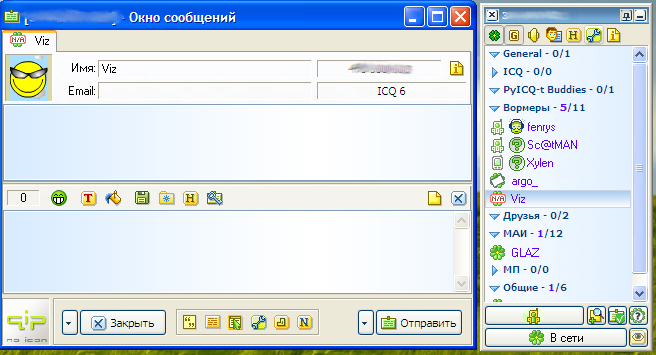
Version: (beta?) Build 8094 (07.27.09)
Protocols: ICQ
OS: Windows
Size: 2 Mb ; Uses
memory: 23 Mb;
Website: qip.ru
So, everyone’s favorite QIP, from the licensing agreement of which we are declared criminals (since why do we use the ICQ protocol which is implemented in quip as if between things ...) :)
You can choose from various options for installing QIP: either the installer, or the installer packed in ZIP, or the installer packed in RAR :) A well-known joke, but, unfortunately, a necessary measure to offer us our convenient services (earlier it was possible to download version without installer). Despite this, QIP remains a portable program, that is, you can install it in a separate folder, pack it, and uninstall the installer - QIP is not attached to the computer in any way.
Let's go further. Bearing in mind recent disturbancesabout the installer, I remember that I am an experienced user, and click "Custom installation (for advanced users)", and in general I understand what caused righteous anger, even Yandex.ICQ in this case gives points where you can remove all the checkmarks, and QIP naturally waiting for the “Next” button to be pressed, the “experienced user” can scream, and select the so-called “Full installation”. This is all nitpicking of course, I just remember that they were interested in the situation and chew it. By the way, at the end I was offered to try IE8 :) I boldly refuse and run QIP.
Our pet is loading, of course, noticeably slower than once ... Despite this, the client was not overgrown with advertising, buttons and other things that were terrifying or frightening. Just QIP.
There is no multi-accountability, the skinability is minimal, settings are even less.
Notifications will only be annoying that I am obliged to update, and they come out regardless of the settings and not in a quiet pop-up, but with a separate interfering window.
An interesting feature: few people know that QIP 2005 has not left the testing stage. The author himself spoke about this when he released QIP Infium. Unfortunately, all references to QIP have miraculously disappeared from Ilham’s blog, and the forum has wiped out relevant topics. I will be glad if someone finds a mention about this :)
I also remind you that the development of QIP 2005 has long been discontinued, but its support continues, that is, the correction of critical vulnerabilities and the release of critical updates.
For whom :
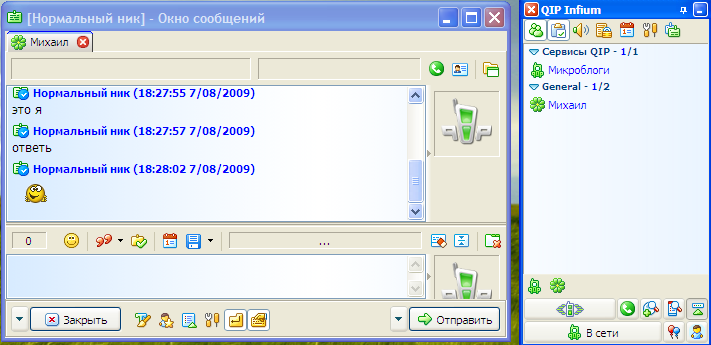
Version: RC4 Build 9030
Protocols: ICQ , Jabber , AIM, Mail.Ru, IRC, SIP + plugins
OC: Windows
Size: 4.7 Mb ; Uses
memory: 6 Mb;
Site: qip.ru
So, this is a more advanced version of QIP looking in the direction of multi-protocol, plug-in and skin-mobility, profile and other things undoubtedly necessary for modern customers.
As always, I was asked to choose between the installer, and the two packaged installers :)
The installer turned out to be more loyal, instead of hiding the settings of their services for the "Advanced Installation", I just honestly show all the checkmarks (already, according to tradition, standing, as it is accepted by the authors of different software). Having unchecked, we move on. The installation, as usual, is instantaneous (essentially unpacking), I do not need QIP.Online.
When I start, I am prompted to store the profile in Application Data and this is correct. If you need portability, select the second item, but if you have a home computer, it’s more correct to store the settings in the folder where the settings are stored (an explanation of this principle is not included in this article, I recommend reading how the file system is organized in Linux).
So, I am offered to register on their service. I refuse and try to enter a profile from the bulldozer. Naturally, it doesn’t work out and they need a profile on their site (it won’t start without it). It’s good that I have my own account a long time ago, I enter it, I see a window of filling in the protocol adding, and suddenly I notice something familiar ...

Oh yes! About the same advertisement in front of me popped up in official clients ...

So, I’m automatically subscribed to microblogs, where my statuses are sent absolutely free of charge, I was happily notified that I have 3 letters in the mail mail.qir.ru (I even went to check it, but that day the mail was apparently out of sorts - just the server was lying), the jabber history is stored on the QIP server, the passwords are stored there :) In the status, I found out how glad I am to quip: “QIP Infium - everything works. Download it on www.qip.ru ”, but did not find the activities and moods of jabber ... apparently they are not needed.
The windows open with a strain, the base's work apparently affects (in the first versions it was terrible).
In isolated mode, QIP no longer requires the use of an account on the site. However, this did not save me from the standard settings, as before, the advertisement got out. Okay, the user must remove it himself, that's okay.
The ability to change skins is called into question. That is, no, of course the interface is changing! There are skins, a great many. But they cannot fundamentally change the interface. The only project that offered full-fledged capabilities for changing the interface, as I understand it, was bent ... or froze. At the moment, skinability is simply a change of colors of different elements and the imposition of various background pictures.
It should be noted that QIP Infium is still a multi-protocol, multi-account, portable program. It has all the necessary popular protocols (the jabber pumped up, it’s not interesting to live without activities and moods), there is a fairly wide selection of plug-ins.
For whom :
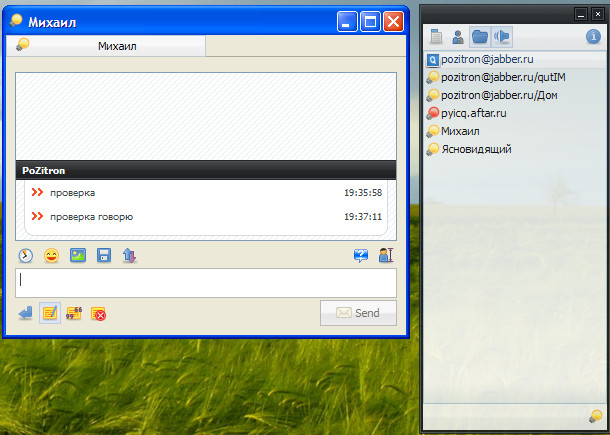
Version: 0.2 Beta 2
Protocols: ICQ , Jabber , Mail.Ru, IRC, Vkontakte
OS: Linux, MacOS, Windows
Size: 9.3 Mb ; Uses
memory: 33 Mb;
Website: qutim.org
Quite an unusual and interesting client (according to statistics) , it is with these words that the description of koutima most often begins). It is distinguished by its incredible cross-platform, simplicity, extensibility due to plugins, good skin-mobility, interesting compatibility with other programs (using styles from other programs: skins, emoticons, icon sets ...).
The program has full support for ICQ and Jabber'a (I just did not check other protocols).
Unfortunately, the program is under active development. At the moment, all sorts of bugs may occur. For example, for some reason, the contact list window was not made wider than a certain size.
For whom :
Hands are reaching out to write “For everyone!”, But that bug with CL still left an impression ...
I specifically left this program in the end, although its description may be the most difficult. If you want, you can relax, concentrate with thoughts ... :)
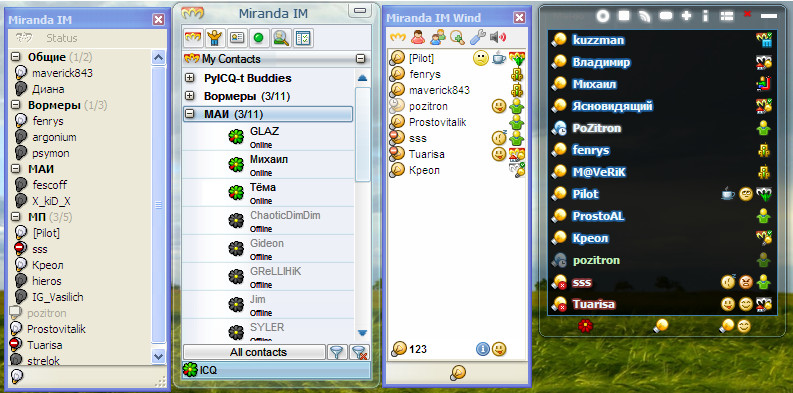
Версия: 0.8.3 (2.08.09)
Протоколы: практически все, за счёт модульности. в стандартный набор входят: ICQ, Jabber, IRC, AIM, MSN, Yahoo, Gadu-Gadu
ОС: Windows
Размер: 1,6 Мб (ядро)
Занимает памяти: 12 Мб (зависит от сборки)
Сайт: miranda-im.org
Нельзя рассматривать Миранду только в «стандартной поставке». Это неправильно. Поэтому сделаем так, рассмотрим отдельно ядро (этим словом можно назвать стандартную Миранду) и отдельно сборки.
The “standard” Miranda can be downloaded in two versions: either the installer, or simply packaged program files. The installer is proposed by default. I trust the "default", I open the installer, very nimble (the size is very small). It suggests choosing the protocols whether to install the import plugin and where to store the profile, in Application Data or in the root of the program. Since I’m not going to take Miranda away from the computer, I select (or rather, it is already selected) in App Data. Installation flew by. The profile manager opens. I create a profile. Now I am offered to create accounts. After creating the necessary accounts, I am convinced that the “naked” Miranda is an amazing combination of minimalism and power.
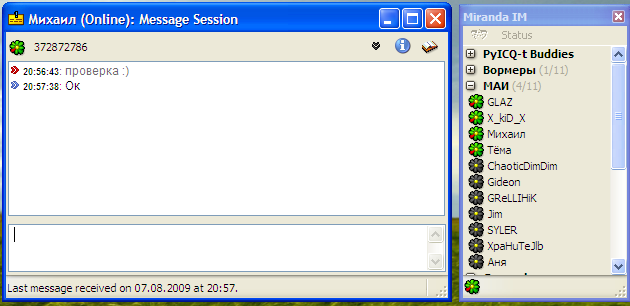
Outwardly, the interface is extremely unremarkable and looks completely deserted. But in fact, already in this position, Miranda can completely transform to any of your requirements thanks to a huge number of settings. The number of settings amazes and confuses the beginner.
However, let me show you a picture taken after I installed two plugins, which are recommended for installation right there, on the download page.
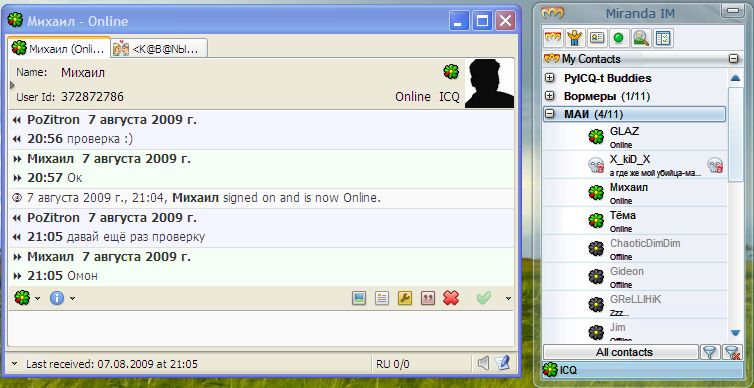
As you can see, Modern Contact List and TabSRMM (total ~ 500 kb) pretty much transformed Miranda. Naturally, there can be no Aero on XP, you see before you how well thought out the skins engine is (this is the same plug-in that I just installed).
As you can see, the core of Miranda is very powerful, stable and, most importantly, you can put a bunch of add-ons on it and change it beyond recognition. But more about that below, in this “subsection”, I wanted to talk about the standard, absolutely “naked” Miranda. As you can see, I didn’t even put Russian into it :)
For whom “Miranda from scratch” is suitable :
An assembly is a certain set of plugins, skins, icons and predefined settings of Miranda that are created by collectors (ordinary people. Even those who just use Miranda, to some extent, collectors, as they change the settings for themselves, install their favorite plugins) and upload for public use. There are a lot of assemblies on the Internet, they are all different, they are very heavy, bulky and universal like a Swiss knife, they are very light, they are portable, there are assemblies focusing on the beauty of the interface ... The imagination of assemblers is endless, there are a lot of different variations.
The purpose of my article is not to talk about the endless possibilities of Miranda, but to give a general idea. So without further ado, believe me that Miranda is power, this is absolute customizability. You can collect a Miranda starting from a completely “naked” client, ending with an incredible “monster” that has EVERYTHING in its arsenal (the only missing plugin is coffee.dll, which would brew coffee and money.dll ... well, you know what I mean).
The “reverse effect” of Miranda is enjoyed by the haters of Miranda (I don’t understand such people at all). They claim that there are too many settings. Too much. Indeed, I saw only a couple of assemblies that would somehow hide the settings from the user, all other assemblies leave the user the right to choose ... and only then I see the problem :)
Ladies and gentlemen, I’m ready to explain why (in my opinion) the newcomer has problems with Miranda. Here the user finds the assembly, downloads. Everything is good, everything is convenient, everything is beautiful and pleasant to talk everywhere ... Suddenly, he sees the settings button. Curiosity certainly prevails, it goes to settings. And then it suddenly occurred to him that this badge should be removed altogether, but this checkmark is superfluous, I don’t like this notice ... A beginner starts scouring the settings. No one has been killed for setting up a client for themselves, but the newcomer sees that there are a lot of them, and many of them do not understand what they are doing. Randomly, like a hurricane, a novice walks through all the checkmarks randomly setting values. After pressing the “OK” button, he safely forgets that he switched over there, sees that his actions “somehow strange” affected Miranda and removes her in “righteous anger”. It is easier for such a beginner to use QIP, where there is simply no freedom of choice. :)
In other words, I urge users to choose assemblies for themselves very carefully (this is essentially like choosing an IM client - each assembly is so different that they can be considered completely different). After you have chosen the assembly, do not immediately try to do something “like in quip” or “like in ICQ”. If you tolerate a little, it will turn out that “like in Miranda” is more convenient :) And yes, of course, you might not be lucky right away and the assembly will not like it. But you have freedom of choice! Choose any other, their sea! Miranda even has its own communities, for example: Miranda-Planet and miranda.im , where there are a lot of interesting things.
Here is a build example:

Miranda Empoli Pack
Agree, much better :)
In general, of course, Miranda has some problems of her own. And there’s even something that I don’t really like. For example, I’m not very happy with the look of the search and the window for changing information about myself. In addition, improperly assembled assemblies, or assemblies with too many plugins, can be very unstable. But it is rather nitpicking. Basically, Miranda is the way I described her. :) It’s a pity she’s not cross-platform.
For whom :
- Here I draw a line under IM-clients :) -
I hope in the end you have chosen a suitable client for yourself :) Or just found out that there are existing ones. Or decided that it makes no sense to holivars, all the customers are good, and someone needs it;)
Reader : Hey! You insulted my favorite means of communication!
Me : Stop-stop. I did not insult anyone. I tried to very objectively consider all kinds of IM clients. I told everything rightly . If there are any constructive comments then I ask in the comments. I am for justice :) And yes, holivar is not a constructive remark;)
H : Yes, here! You scoffed at my place in this place! You have a minus ...
I : No, this is my storytelling style. When I speak in a free, slightly mocking style, this leads me to clearer thoughts, I can state the problem more precisely if I play a trick on it. :) And I ask, do not have minuses, this is my first article on the hub ; D
H : Why were only ICQ and Jabber considered?
Me : In my opinion, these are the most interesting means of communication for Russia (the CIS and Europe in general).
Ch : “Takes memory” - what else is it?
Me : Amount of memory used during program operation. Very subjective assessment and does not affect anything. Do not pay attention, it does not give an objective picture.
C : And where are my favorite Gtolk / Mail.ru?
Me : These programs do not allow access to the jabber network except from your server. I'm sorry. But all the other programs in the review support them.
C : How to understand "For whom"?
Me : It is necessary to understand this so that if at least one of the conditions is suitable, then the person in question is most likely suitable for this person.
H: Why is the review so long?
Me : Because “the most complete”. I tried to track all the programs in the review .
C : Why do not I see my favorite program in the review, which is very popular in Europe?
Me : Unfortunately, we have not quite that Europe. The programs that I did not consider were English-speaking, and as a rule with a very persistent binding to their services . Most of the country's population is frightened by the ability to understand the English language (rather than calmly use the program). In addition, it should be noted separately (because there are many questions on this topic) that I did not specifically consider clients where they are forced to become attached to a particular service.
No, my topic review does not call for using any special new customers, but I hope it will make you think and choose the most suitable one. :)
Most likely, many Khabrovsk residents already have their favorite client, for which they are ready to strangle any "ill-wisher" :) I ask holivarschik to leave, here I just do a review, draw a line under the current state of things. For those who are interested, who are hungry for a new one, who are fed up with their means of communication and other people who are interested, please view the review. IM clients with a graphical user interface on a PC (Windows and Linux) will be considered .
Attention! ~ 1.5 Mb pictures, and a sea of text
For the review we used:
Netbook
ASUS EeePC 1000H
System: Windows XP SP3
PC
Core 2 Duo E7200
System: Ubuntu Linux 9.04
Pidgin

Version: 2.5.8
Protocols: Jabber (XMPP), ICQ , MSN, IRC, SIP, Bonjour iChat, Gadu-Gadu, Novell GroupWise, OpenNAP, SILC, Zephyr, Lotus Sametime, QQ, MySpaceIM + plugins
OS: Linux, Windows, MacOS
Size: 13.7 Mb; Uses
memory: 50 Mb;
Amazes the number of supported protocols. However, as in many other similar clients, Mail.ru is missing here.
The client itself is both simple and convenient, and very functional. The program comes with a standard set of modules, and the program itself is not deprived of chips. This is what distinguishes Pidgin from other programs - there are "chips" that are difficult to see elsewhere. Well, for example, "user tracking", which greatly expands the possibilities of notification. There are some individual settings, for example, some lacking function of setting your own avatar, instead of the avatar that the interlocutor offers you.
Of course, a client with so many protocols needs to have meta contacts, and even Pidgin can cope with this task.
It seemed nowhere to throw a fly in the ointment, but no! Pidgin has deficiencies: these are statuses and the absence of a “service review”. Yes, the statuses in Pidgin’s standard work fine, but no activities, moods, or, more understandably for ICQ fans, xStatuses, were planned. Here it is. The haVok habrozer suggests that the xStats are promised in version 2.7.0 , you can only wait and hope. Since the protocols do not support the extended statuses, the
“Service Overview” is needed, for example, to add transport. Although on the other hand, this is a multi-protocol client, transports are not needed here in most cases.
The client itself will suit the "average user", but still no more than that, since there is no way to modify the interface.
For whom :
- For those who like a fairly simple interface with good functionality and many protocols.
- Who needs a lot of protocols, and statuses are not interested.
- For those with a Gnome desktop
Empathy

Version: 2.27.5
Protocols: XMPP (Jabber), ICQ , SIP, AIM, MSN, QQ, Yahoo, GroupWise, Gadu-Gadu, Salut
OS: Unix-like
Site: http://live.gnome.org/Empathy
Program it turned out to be so simple that there was nothing to “review” it.
In general, the program looks like it is Pidgin at the time of the beginning of development. This feeling arises due to the contrast of functionality and interface. The interface is terribly minimalistic, it is simple as 5 kopecks, so simple that even the icons at the contacts of different protocols do not differ! But after looking at my list, don’t think that I love it when a sheet of paper lies in front of me, it’s just impossible to do the same contact list. By functional, I mean the number of supported protocols, including voice communication over SIP and Google Talk . In addition, immediately after installation, the program correctly detected that I had profiles configured in Pidgin, and it also successfully (with my permission) imported them.
Naturally, this thing does not support any additional statuses. But even worse, Service Overview is not supported either, that is, you will not be able to work with Jabber transports.
For whom :
- For those who can not stand the piling up of the interface, but at the same time want to sit in many networks at the same time.
IMadering

Version: 5.0.0 alfa (07/30/09, updated to 6.08.09)
Protocols: ICQ
OC: Windows
Size: 1.2 Mb ; Uses
memory: 10 Mb;
Website: imadering.com
I was shocked to see this program! Memories immediately flooded when QIP was easier, the air is cleaner, and the girls are more beautiful ... Alas, it turned out that the program is at a very early stage of development. No, in fact, it has already been developed for a long time, but the author decided to start the project again, and therefore I was at first slightly surprised that the jabber was not connected, and then I felt completely lonely after seeing an absolute lack of settings. Despite this, the client is apparently under active development, many features of the ICQ protocol are already supported (including x-statuses).
For whom :
- Those who stupidly need to talk in ICQ, as in the good old days.
- Run the “left” numbers (sometimes you need to exit the “unknown” number and write to someone, or check something ...)
- Carry on a flash drive ... just in case
Kopete

Version: 0.70.2 (2.04.09)
Protocols: ICQ , Jabber , AIM, Yahoo, Windows Live, QQ, Gadu-Gadu, Bonjour, GroupWise, Meanwhile, SMS, WinPopup (description: sends WinPopup messages)
OS: Unix- similar
takes up memory: 27 Mb
Site: kopete.kde.org Pidgin's
answer? Or Pidgin Kopete's answer? I don’t know, but this is a monster, and very impressive. Unlike Pidgin, Kopete lacks that gracefully crammed settings in different angles. All settings drop out from somewhere from the menus or can be found on some tab, or hidden in a separate menu as a separate line in a separate window ... In general, despite the external simplicity, the client surprises with his pop-up-check-out-creep settings. In general, it’s somehow good, because no one has yet died from a flexible client :) In addition, Kopete supports x-statuses and moods (though I didn’t see activities there ).
The problem with Kopete is its focus on KDE. I admit that in KDE it looks beautiful and probably fits into the interface, but in Gnome it is out of place and it sometimes even seems to me that it slows down. Besides who wants to drag a bunch of KDE'shnyh libraries? (I'm talking about the total traffic necessary to download the program).
For whom :
- For KDE Users
- For other Unix users who love a lot of features in one bottle
SIM

Version: 0.9.5.2 (11.28.08)
Protocols: ICQ , Jabber , AIM, MSN, Yahoo, LiveJournal
OS: Windows, Linux, FreeBSD
Memory space: 12 MB
Website: sim-im.org
Quite a strange project, I can’t name any features. There are cons: the interface is bad and there are no x-statuses, but I do not see any advantages. Just a program. There are some chips of their own, but there are few of them and they are not worthy of mention.
In addition, the client is more focused on KDE and does not seem to be developing.
For whom :
- Hard to say, probably for no one
Gajim

Version: 0.12.3 (12.06.09)
Protocols: Jabber
OS: Linux, BSD, Windows ; Uses
memory: 50 Mb;
Website: gajim.org
Once upon a time, I started this program for the first time. That day I rubbed my hands and thought “finally I found a simple jabber-client for friends who just need a simple one without any extra buttons!”. For a while, to help my friends, I sat on Gajim ... what was my surprise when I realized that I was just sitting on it! Gajim surprisingly accurately found the middle ground between beauty, functionality and simplicity.
Beauty: Gadzhim is not decorated without the possibility of using skins. However, the interface is so licked that it is not necessary.
Functionality: despite its apparent simplicity, the clientperfectly fulfills its duties. The client fully supports Jabber with all its documented features. Many things are thought out for pleasant communication.
Simplicity: all the necessary settings are where they should be. The number of settings (visible) is quite modest, which does not allow you to get confused in the client, but there is a special button with an advanced settings tree where you can configure the client well once and forget about them forever :)
Of the minuses, it is worth noting sometimes errors (but not client, but simply showing that an error has occurred) and freezes when it is not possible to connect to the server.
For whom :
- If you use mainly jabber, then perhaps it is better not to find a client
- If you are going to switch to jabber, you can use Gajim with the transport connected. That's what I did for a long time
Psi

Version: 0.13 (07/27/09)
Protocols: Jabber
OS: Windows, Linux, Mac OS
Takes up memory: 30 mb
Website: psi-im.org
It looks like a simple Jabber-client. The regular version does not support activity; the advanced versions (Psi +) partially support them. Moods are supported, but pretty banal - just text, without an icon. A music show (tune) is also present.
As in Gajim, many settings are hidden from the user in a special settings tree, which allows you to quickly change frequently used settings, while leaving the ability to sometimes “fine-tune” the client. "In general, the client is not inferior to Gajim in functionality. But the external kind of an amateur.
For whom :
- If you just need a jabber and are comfortable with the interface.
Maybe for the Mak'ovtsy?
Yandex.ICQ

Version: 6.5
Protocols: ICQ
OS: Windows
Size: 15.8 Mb + required updates;
memory: 77 Mb
Website: icq.yandex.ru The
answer to Yandex Rambler is “Yandex with Yandex taste”. When I saw how the installation wizard starts and the hard drive rustles helplessly, I realized that I was putting the official ICQ. Seeing a nice plastic installer interface that any 5th grader could do, I clicked “Next” and, remembering the situation with QIP, clicked on “Custom installation”. So it is, immediately hidden appearedpoints where I was not asked to choose which ICQ components I want to install, but 3 ticks were offered with all sorts of “make yandex home page” and other “advertising”. Having removed all the checkmarks, I started the installation. It lasted quite a long time, without asking me to climb something to download from the Internet, and so on, as befits an official client. At the end of the installation, I immediately checked “Run ICQ”, after which I was again waiting for downloading updates of an already installed client (for those who don’t know, the official client will not work without updates, so one day you can be left without ICQ). Next, the same plastic-white-gray interface appeared in front of me. Having visited Yandex with Yandex taste, I was convinced that this client does not contain any changes compared to regular ICQ.
I tried to send SMS, of which 20 there are "free". It did not reach the addressee. Constantly the field below is closed with a white square “Chivelam” - apparently there should be an advertisement. This square itself occupies just half of the list, which, incidentally, is not subject to special resizing. It’s painful to look at the list of contacts, it’s the same as reading a book at a distance of 5 meters - a little contacts are placed close because of the huge “cap” and useless flash insert below.
But in this client there are completely useless “tricks”: games (by the way, my favorite “Lamb War” - I recommend), tZer (extremely dumb flash cartoons sent to the interlocutor), Zlango (shows pictures explaining the text above the text), and also video audio calls (it’s not clear how, I haven’t tried it), flash chat and other nonsense. It has long been clear that ICQ does not even think to improve the protocol. What for? It is more complicated, it requires the presence of brains, and other customers can jump. Instead, a bunch of any flash content is put on, which only does what it eats through the traffic, shows ads and slows down the entire computer.
You can also forget about several running numbers: the program does not allow itself to be launched 2 times and the ability to use several numbers at the same time is also not provided.
The only thing that pins me in this client is pop-up messages, I have never seen them pop up so cool “from a puddle”. :)
For whom :
- For those who have fast and endless Internet, a large enough monitor and not a weak computer
- For those who need not so much communication as eternal entertainment, like flash games with friends, listening to the radio, throwing cartoons ...
- For those who like a plastic interface with a beautiful smooth transfusion and messages from the puddle.
Rambler.ICQ

Version: 6.5
Protocols: ICQ
OS: Windows
Size: 15.8 Mb + required updates;
memory: 68 Mb
Website: icq.rambler.ru
All of them, official clients, are the same. And yet, there is some difference.
The installer at Rambler turned out to be more thoughtful, there is more animation that allows you to escape from a long installation. By the way, the situation with QIP and Yandex.ICQ does not repeat here. This is me about the fact that when you put Rambler.ICQ, the checkboxes with a subscription to ramble services are not hidden under the “advanced installation”, they are visible in the palm of your hand.
From Rambler.ICQ, I got a message to the recipient. True, it turned out that 20 free SMS are tied to a number (or a computer?), So I already have 18 left :)
Otherwise, they are completely identical.
For whom :
- For those who have fast and endless Internet, a large enough monitor and not a weak computer
- For those who need not so much communication as eternal entertainment, like flash games with friends, listening to the radio, throwing cartoons ...
- For those who like a plastic interface with a beautiful smooth transfusion and messages from the puddle.
ICQ
- // - Website: icq.com
Rambler.ICQ with a green interface.
- // -
ICQ Lite

Version: 1.0
OS: Windows
Size: 9.2 Mb + required updates
Website: icq.com
We took ICQ, cut out the entire flash from it, made the interface a gray gradient in the Macintosh style (remember the good old QuickTime), decided that the eggplant color would be the best and this miracle was laid out to us.
For whom :
- For those who do not like the abundance of flash, but need an official client.
R&Q

Version: 1105 (08/10/08)
Protocols: ICQ, Mail.ru
OC: Windows
Size: 1.2 Mb ; Uses
memory: 22 Mb;
Website: rnq.ru
Keeping in 1.2 Mb, we get a pretty functional client. There is all ICQ functionality. For some reason I did not find multi-accounts, it is probably assumed that you need to run several copies of the client. At the same time, R&Q has a certain skinnability, on the official website there are various skins, plugins, emoticon sets and more for it. However, those who say that the interface is rather miserable will be right. Something in the interface is wrong, it looks a bit rustic.
For whom :
- Who needs external simplicity, but good functionality (in other words, those whom QIP 2005 does not suit with the lack of settings and plugins)
- For those who need ICQ and Mail.ru in one bottle, while simplicity is needed in the client itself
- Who needs the simplest interface, portability and just working ICQ / mail.ru
Naturally, I left the most interesting in the end ...
QIP 2005

Version: (beta?) Build 8094 (07.27.09)
Protocols: ICQ
OS: Windows
Size: 2 Mb ; Uses
memory: 23 Mb;
Website: qip.ru
So, everyone’s favorite QIP, from the licensing agreement of which we are declared criminals (since why do we use the ICQ protocol which is implemented in quip as if between things ...) :)
You can choose from various options for installing QIP: either the installer, or the installer packed in ZIP, or the installer packed in RAR :) A well-known joke, but, unfortunately, a necessary measure to offer us our convenient services (earlier it was possible to download version without installer). Despite this, QIP remains a portable program, that is, you can install it in a separate folder, pack it, and uninstall the installer - QIP is not attached to the computer in any way.
Let's go further. Bearing in mind recent disturbancesabout the installer, I remember that I am an experienced user, and click "Custom installation (for advanced users)", and in general I understand what caused righteous anger, even Yandex.ICQ in this case gives points where you can remove all the checkmarks, and QIP naturally waiting for the “Next” button to be pressed, the “experienced user” can scream, and select the so-called “Full installation”. This is all nitpicking of course, I just remember that they were interested in the situation and chew it. By the way, at the end I was offered to try IE8 :) I boldly refuse and run QIP.
Our pet is loading, of course, noticeably slower than once ... Despite this, the client was not overgrown with advertising, buttons and other things that were terrifying or frightening. Just QIP.
There is no multi-accountability, the skinability is minimal, settings are even less.
Notifications will only be annoying that I am obliged to update, and they come out regardless of the settings and not in a quiet pop-up, but with a separate interfering window.
An interesting feature: few people know that QIP 2005 has not left the testing stage. The author himself spoke about this when he released QIP Infium. Unfortunately, all references to QIP have miraculously disappeared from Ilham’s blog, and the forum has wiped out relevant topics. I will be glad if someone finds a mention about this :)
I also remind you that the development of QIP 2005 has long been discontinued, but its support continues, that is, the correction of critical vulnerabilities and the release of critical updates.
For whom :
- Who needs a client with minimal functionality
- “If only it worked.” Who needs ICQ to just work, show statuses, and you can set these statuses yourself.
- “Without troubles” - who doesn’t want to take a steam bath and look for where is the search and so on, and to immediately write “HELLO. HOW DOES? ”And communicate
QIP Infium

Version: RC4 Build 9030
Protocols: ICQ , Jabber , AIM, Mail.Ru, IRC, SIP + plugins
OC: Windows
Size: 4.7 Mb ; Uses
memory: 6 Mb;
Site: qip.ru
So, this is a more advanced version of QIP looking in the direction of multi-protocol, plug-in and skin-mobility, profile and other things undoubtedly necessary for modern customers.
As always, I was asked to choose between the installer, and the two packaged installers :)
The installer turned out to be more loyal, instead of hiding the settings of their services for the "Advanced Installation", I just honestly show all the checkmarks (already, according to tradition, standing, as it is accepted by the authors of different software). Having unchecked, we move on. The installation, as usual, is instantaneous (essentially unpacking), I do not need QIP.Online.
When I start, I am prompted to store the profile in Application Data and this is correct. If you need portability, select the second item, but if you have a home computer, it’s more correct to store the settings in the folder where the settings are stored (an explanation of this principle is not included in this article, I recommend reading how the file system is organized in Linux).
So, I am offered to register on their service. I refuse and try to enter a profile from the bulldozer. Naturally, it doesn’t work out and they need a profile on their site (it won’t start without it). It’s good that I have my own account a long time ago, I enter it, I see a window of filling in the protocol adding, and suddenly I notice something familiar ...

Oh yes! About the same advertisement in front of me popped up in official clients ...

So, I’m automatically subscribed to microblogs, where my statuses are sent absolutely free of charge, I was happily notified that I have 3 letters in the mail mail.qir.ru (I even went to check it, but that day the mail was apparently out of sorts - just the server was lying), the jabber history is stored on the QIP server, the passwords are stored there :) In the status, I found out how glad I am to quip: “QIP Infium - everything works. Download it on www.qip.ru ”, but did not find the activities and moods of jabber ... apparently they are not needed.
The windows open with a strain, the base's work apparently affects (in the first versions it was terrible).
In isolated mode, QIP no longer requires the use of an account on the site. However, this did not save me from the standard settings, as before, the advertisement got out. Okay, the user must remove it himself, that's okay.
The ability to change skins is called into question. That is, no, of course the interface is changing! There are skins, a great many. But they cannot fundamentally change the interface. The only project that offered full-fledged capabilities for changing the interface, as I understand it, was bent ... or froze. At the moment, skinability is simply a change of colors of different elements and the imposition of various background pictures.
It should be noted that QIP Infium is still a multi-protocol, multi-account, portable program. It has all the necessary popular protocols (the jabber pumped up, it’s not interesting to live without activities and moods), there is a fairly wide selection of plug-ins.
For whom :
- For those who are not afraid that they hang a bunch of services on him (and who even likes it, because such programs are designed to use the services, then it is really convenient to work in it)
- For those who trust RBC, and are not afraid that his mail, accounts and passwords may be unknown to anyone
- For those who can disable everything, including mailing and spamming in ICQ (and this is just a rumor)
- For fans of quip as a program (rather than a “classic” quip)
- For those who, for whatever reason, have not mastered Miranda and qutIM, but want plugins
qutIM

Version: 0.2 Beta 2
Protocols: ICQ , Jabber , Mail.Ru, IRC, Vkontakte
OS: Linux, MacOS, Windows
Size: 9.3 Mb ; Uses
memory: 33 Mb;
Website: qutim.org
Quite an unusual and interesting client (according to statistics) , it is with these words that the description of koutima most often begins). It is distinguished by its incredible cross-platform, simplicity, extensibility due to plugins, good skin-mobility, interesting compatibility with other programs (using styles from other programs: skins, emoticons, icon sets ...).
The program has full support for ICQ and Jabber'a (I just did not check other protocols).
Unfortunately, the program is under active development. At the moment, all sorts of bugs may occur. For example, for some reason, the contact list window was not made wider than a certain size.
For whom :
Hands are reaching out to write “For everyone!”, But that bug with CL still left an impression ...
- For those who think that “quip is not the same”
- Just an alternative to QIP: multi-accountable and plugin-like QIP Infium and easy and simple like QIP 2005
- For those who are looking for something "easy" on Unix-like systems
- For those who are not afraid to test programs
I specifically left this program in the end, although its description may be the most difficult. If you want, you can relax, concentrate with thoughts ... :)
Miranda IM

Версия: 0.8.3 (2.08.09)
Протоколы: практически все, за счёт модульности. в стандартный набор входят: ICQ, Jabber, IRC, AIM, MSN, Yahoo, Gadu-Gadu
ОС: Windows
Размер: 1,6 Мб (ядро)
Занимает памяти: 12 Мб (зависит от сборки)
Сайт: miranda-im.org
Нельзя рассматривать Миранду только в «стандартной поставке». Это неправильно. Поэтому сделаем так, рассмотрим отдельно ядро (этим словом можно назвать стандартную Миранду) и отдельно сборки.
Ядро
The “standard” Miranda can be downloaded in two versions: either the installer, or simply packaged program files. The installer is proposed by default. I trust the "default", I open the installer, very nimble (the size is very small). It suggests choosing the protocols whether to install the import plugin and where to store the profile, in Application Data or in the root of the program. Since I’m not going to take Miranda away from the computer, I select (or rather, it is already selected) in App Data. Installation flew by. The profile manager opens. I create a profile. Now I am offered to create accounts. After creating the necessary accounts, I am convinced that the “naked” Miranda is an amazing combination of minimalism and power.

Outwardly, the interface is extremely unremarkable and looks completely deserted. But in fact, already in this position, Miranda can completely transform to any of your requirements thanks to a huge number of settings. The number of settings amazes and confuses the beginner.
However, let me show you a picture taken after I installed two plugins, which are recommended for installation right there, on the download page.

As you can see, Modern Contact List and TabSRMM (total ~ 500 kb) pretty much transformed Miranda. Naturally, there can be no Aero on XP, you see before you how well thought out the skins engine is (this is the same plug-in that I just installed).
As you can see, the core of Miranda is very powerful, stable and, most importantly, you can put a bunch of add-ons on it and change it beyond recognition. But more about that below, in this “subsection”, I wanted to talk about the standard, absolutely “naked” Miranda. As you can see, I didn’t even put Russian into it :)
For whom “Miranda from scratch” is suitable :
- Obviously, for those who want complete minimalism combined with tremendous power
- For those who want to create their favorite client from scratch. Believe me, if you yourself choose all the necessary modules, skins, icons, etc. for yourself, the result will be the ideal client for you
- For those who want to use Miranda somewhere purposefully. For example, you can make an assembly taking into account the features of the company or specifically for the local network.
Builds and other features of Miranda
An assembly is a certain set of plugins, skins, icons and predefined settings of Miranda that are created by collectors (ordinary people. Even those who just use Miranda, to some extent, collectors, as they change the settings for themselves, install their favorite plugins) and upload for public use. There are a lot of assemblies on the Internet, they are all different, they are very heavy, bulky and universal like a Swiss knife, they are very light, they are portable, there are assemblies focusing on the beauty of the interface ... The imagination of assemblers is endless, there are a lot of different variations.
The purpose of my article is not to talk about the endless possibilities of Miranda, but to give a general idea. So without further ado, believe me that Miranda is power, this is absolute customizability. You can collect a Miranda starting from a completely “naked” client, ending with an incredible “monster” that has EVERYTHING in its arsenal (the only missing plugin is coffee.dll, which would brew coffee and money.dll ... well, you know what I mean).
The “reverse effect” of Miranda is enjoyed by the haters of Miranda (I don’t understand such people at all). They claim that there are too many settings. Too much. Indeed, I saw only a couple of assemblies that would somehow hide the settings from the user, all other assemblies leave the user the right to choose ... and only then I see the problem :)
Ladies and gentlemen, I’m ready to explain why (in my opinion) the newcomer has problems with Miranda. Here the user finds the assembly, downloads. Everything is good, everything is convenient, everything is beautiful and pleasant to talk everywhere ... Suddenly, he sees the settings button. Curiosity certainly prevails, it goes to settings. And then it suddenly occurred to him that this badge should be removed altogether, but this checkmark is superfluous, I don’t like this notice ... A beginner starts scouring the settings. No one has been killed for setting up a client for themselves, but the newcomer sees that there are a lot of them, and many of them do not understand what they are doing. Randomly, like a hurricane, a novice walks through all the checkmarks randomly setting values. After pressing the “OK” button, he safely forgets that he switched over there, sees that his actions “somehow strange” affected Miranda and removes her in “righteous anger”. It is easier for such a beginner to use QIP, where there is simply no freedom of choice. :)
In other words, I urge users to choose assemblies for themselves very carefully (this is essentially like choosing an IM client - each assembly is so different that they can be considered completely different). After you have chosen the assembly, do not immediately try to do something “like in quip” or “like in ICQ”. If you tolerate a little, it will turn out that “like in Miranda” is more convenient :) And yes, of course, you might not be lucky right away and the assembly will not like it. But you have freedom of choice! Choose any other, their sea! Miranda even has its own communities, for example: Miranda-Planet and miranda.im , where there are a lot of interesting things.
Here is a build example:

Miranda Empoli Pack
Agree, much better :)
In general, of course, Miranda has some problems of her own. And there’s even something that I don’t really like. For example, I’m not very happy with the look of the search and the window for changing information about myself. In addition, improperly assembled assemblies, or assemblies with too many plugins, can be very unstable. But it is rather nitpicking. Basically, Miranda is the way I described her. :) It’s a pity she’s not cross-platform.
For whom :
- For those who are not afraid of the choice (even in the number of assemblies you can get lost, I generally am silent about the settings)
- For everyone who is not too lazy to find a build for themselves
- For those who like to customize everything for themselves. Everything.
- Who needs a real harvester. I can’t name you a single client where else could you see such a variety of protocols, starting from the most common, ending with access to FTP (QIP Infium tries to get closer to the same situation)
- For those who love variety. You can change skins and Miranda you never get tired
- Here I draw a line under IM-clients :) -
Total:
I hope in the end you have chosen a suitable client for yourself :) Or just found out that there are existing ones. Or decided that it makes no sense to holivars, all the customers are good, and someone needs it;)
Pochemuchki or Questions from the Reader
Reader : Hey! You insulted my favorite means of communication!
Me : Stop-stop. I did not insult anyone. I tried to very objectively consider all kinds of IM clients. I told everything rightly . If there are any constructive comments then I ask in the comments. I am for justice :) And yes, holivar is not a constructive remark;)
H : Yes, here! You scoffed at my place in this place! You have a minus ...
I : No, this is my storytelling style. When I speak in a free, slightly mocking style, this leads me to clearer thoughts, I can state the problem more precisely if I play a trick on it. :) And I ask, do not have minuses, this is my first article on the hub ; D
H : Why were only ICQ and Jabber considered?
Me : In my opinion, these are the most interesting means of communication for Russia (the CIS and Europe in general).
Ch : “Takes memory” - what else is it?
Me : Amount of memory used during program operation. Very subjective assessment and does not affect anything. Do not pay attention, it does not give an objective picture.
C : And where are my favorite Gtolk / Mail.ru?
Me : These programs do not allow access to the jabber network except from your server. I'm sorry. But all the other programs in the review support them.
C : How to understand "For whom"?
Me : It is necessary to understand this so that if at least one of the conditions is suitable, then the person in question is most likely suitable for this person.
H: Why is the review so long?
Me : Because “the most complete”. I tried to track all the programs in the review .
Addition...
C : Why do not I see my favorite program in the review, which is very popular in Europe?
Me : Unfortunately, we have not quite that Europe. The programs that I did not consider were English-speaking, and as a rule with a very persistent binding to their services . Most of the country's population is frightened by the ability to understand the English language (rather than calmly use the program). In addition, it should be noted separately (because there are many questions on this topic) that I did not specifically consider clients where they are forced to become attached to a particular service.
